Six powerful lessons we wish we’d known before switching into data science six months ago.
This article was written by Rosana de Oliveira Gomes, Lead Machine Learning Engineer at Omdena, and Joseph Itopa A, Junior Machine Learning Engineer at Omdena.
Transitioning into a new career can feel like boarding a plane that’s already taking off. The data science profession is relatively new, which means that many data scientists and machine learning engineers didn’t start their careers on this path. They switched from other fields like we did, and perhaps like many of you reading this. So let’s talk about what tools and skills you need to transition into data science—we’ll highlight possible challenges and give you practical advice on how to overcome them.
Technical challenges and how to overcome them
1. Brush up on math and programming
Data science doesn’t require advanced math knowledge beyond what’s required for any science degree. But every artificial intelligence algorithm is based on some mathematical structure which you will need to understand. This usually involves linear algebra and some concepts from calculus. To interpret results, you will need to conduct statistical analysis, which also requires knowledge of probability and statistics.
While math provides the concepts, programming languages are the tools to make those concepts tangible. This means that you have to choose a programming language to learn, which in this field usually is either Python or R, likely combined with SQL and Bash. A KDnuggets poll on programming software used by data scientists reveals that Python has surpassed R as the tool of choice.
But the choice of a programming language essentially boils down to the task at hand and style preferences. Python is easy to pick up for someone who has experience with programming, and is widely used across industries and specialties such as data science and machine learning. R is a good choice too if you have a statistics background and will be working mostly on analysis. It also has built-in tools and libraries to communicate results through reports. Our advice is to stick with one language and start building something after you are done with the basics.
Speaking from experience, we’ve learned that to acquire the necessary skills in data science, you should choose only one learning provider at a time and stick with it. The worst thing you can do is to keep learning the same things over and over.
2. Become a problem solver
You can view the science of data science as the ability to solve problems with creative and logical thinking. This requires knowledge of programming and an understanding of algorithms gained through practice.
After acquiring some basic knowledge of programming, you can begin solving real-world problems by practicing via courses or platforms. GeeksforGeeks provides hands-on projects for competitive coding, Python, JAVA, and SQL. Solving some Kaggle competition problems can also boost your problem-solving skills, as you can easily leverage real-world data to practice with and find a lot of help in the community. DataCamp’s unguided projects are a great way to find your own solutions to open-ended projects.
It’s important that you find enjoyment in these accomplishments to pursue a data science career. In a recent Omdena webinar, data science influencer Eric Weber said, “Don’t optimize for income only but for what brings you joy; otherwise, you may burn out quickly.”
3. Join collaborative projects
After working with some algorithms and practicing on a few projects, you will be ready for more advanced projects. This is where collaborative platforms come in. Collaborative data science programs rely on communities to develop projects in a diverse and productive way. The ruggedness and fun in street coding is best found in collaborative projects. You will learn from others as they learn from you. You will make friends while struggling with unstructured and messy data—there’s nothing like it.
Inspiring collaborative initiatives include Data Kind, Science to data science, and Data Science for Social Good. These options are often location-specific and may be costly or competitive due to limited availability and an extensive application process.
An alternative to collaborative projects is Omdena, which launches several projects per month and applies a principle of volunteering to solve real-world problems through online collaboration. Learners work with domain experts who will help them stay motivated with webinars, courses, books, and blog posts.
Potential non-technical challenges and how to overcome them
1. Organization and time management skills
Changing careers is a project. It requires a strategic plan, a timeline, and specific (and realistic) milestones. Ask yourself these questions:
- Why do I want to be a data scientist and what subjects am I passionate about?
- Will I quit my job and take the time to learn the skills I need or will I make the transition in parallel with my current work?
- What am I good at? What are my weaknesses?
- How much time and money am I willing to spend on changing careers?
- What are the new skills and qualifications that I need to acquire for the new career path?
- What is my learning style?
Once you answer these truthfully, you need a plan. In the end, you have to find what works for you. Here are some things you can do:
- Print a weekly plan and stick it on your wall.
- Organize your daily schedule on a Google calendar.
- Identify what works and what needs to be readjusted in your plan. Maybe you underestimated how much time you needed for a course or the learning resource you chose is not quite as you imagined.
- Don’t be afraid to change your strategy. Go to online forums and search for a better resource. Or read some articles on time management and read on how to set SMART goals.
- Keep checking tasks off your to-do list. This momentum will push you out of that initial frustration period of learning something new.
2. Become a better communicator
Another must-have skill for data science is communication. A data scientist translates tons of data into actionable insights for decision makers and stakeholders. However, not all the people that you will need to communicate with are data scientists or have a background in STEM. If you’re an introvert, you may not be super excited about public speaking or constant communication. Communication in data science is not only about being a good speaker but also about building these habits and skills:
- Provide good explanations of complex concepts to non-experts.
- Document code and analysis so other team members can learn from your work in the future (or even your future self!).
- Become a good writer by making a habit of writing about everything you do in your career path.
Documentation is power, so write and keep writing. In the very near future, you will need to demonstrate the skills that you put on your resume, and you can back them via nicely documented code repositories (for example, on GitHub), blog posts, and webinars or talks about your work. The earlier you start, the faster you’ll improve.
3. Be prepared to fight imposter syndrome
One common challenge experienced by many career movers is imposter syndrome. It’s never easy having an established career and suddenly becoming a newbie. In this case, it’s all a matter of mindset: keep yourself motivated and excited about all the new things you are about to learn! Omdena has hosted a webinar on how to overcome imposter syndrome as a data scientist, which includes knowing the skills gap that you need to fill and identifying the skills you already learned from your previous career.
4. Build your network
Networking on your job hunt doesn’t have to be awkward. In fact, statistically, the majority of job opportunities come from an individual’s network, not from applications (check the references here and here). When you network, you’re simply connecting to people who have similar interests as you, getting their take on data science topics, and getting a peek into their careers. These people may become your future colleagues. The absolute worst thing that can happen is not getting any response—what do you have to lose?
One of the easiest ways to network is through collaborative projects, where you have the opportunity to share knowledge, work with experienced practitioners, and gain insights from people in different roles, and find leads for jobs.
Another good way to network is by following authorities in data science such as:
Contact any interesting people you encounter—a speaker from a podcast you liked, a teacher from an online course, or a blogger whose posts you enjoy. The golden rule is: Put yourself out there and ask questions. That’s the best way to get feedback.
Source: Datacamp

